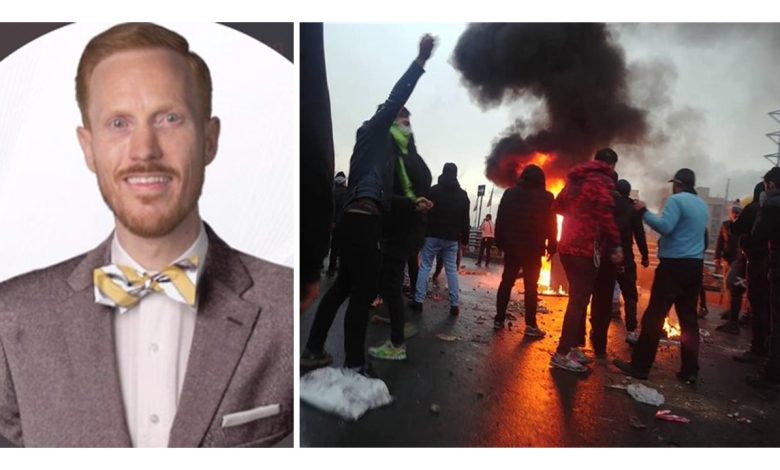Amplifying Iranian Voices: The Call for Freedom and Democracy Amidst Political Turmoil

Written by
Staff Writer
In an insightful piece on Star and Stripes, Professor Ivan Sascha Sheehan, the associate dean of the College of Public Affairs, analyzes the ongoing political turmoil in Iran, with a focus on the recent anti-government protests that erupted across the country. Despite the brutal crackdown by the regime, Iranians’ unwavering demand for civil and political liberties has not subsided. Prof. Sheehan examines the various political figures vying for power and presents a compelling argument against the return of the Pahlavi dictatorship. Instead, Sheehan advocates for the 10-point plan presented by Mrs. Maryam Rajavi, which promotes free and fair elections and the separation of religion from the state. As the debate about Iran’s future intensifies, the author reminds us that it is crucial to amplify the voices of Iranians fighting for freedom and democracy, not those seeking a return to an oppressive past.
Following is Prof. Sheehan’s article:
The Islamic Republic of Iran has posed a significant challenge for Western policymakers since the establishment of the theocracy by Ayatollah Ruhollah Khomeini 44 years ago. But Iranians’ uncompromising pursuit of civil and political liberties may finally be paying off.
Though the latest round of anti-government protests were sparked by the killing of a 22-year-old Kurdish-Iranian woman, Mahsa Amini, by the so-called “morality police” for reportedly wearing a headscarf incorrectly in September 2022, the uprising quickly metastasized with Iranians taking to the streets to participate in a country-wide rebellion and insisting on the removal of the clerical regime in its entirety.
According to the leading pro-democracy opposition group, the People’s Mujahedin Organization of Iran (PMOI/MEK), more than 750 people have been killed over the past seven months in the regime’s latest crackdowns, with 30,000 others arrested. Although some media outlets report lower estimates of both figures, authorities in Tehran claimed in March to have granted amnesty to 22,000 people arrested during the anti-regime uprising, effectively confirming the MEK’s accounts.
While the ayatollahs and their disinformation units try to present an image of normalcy, outrage, and defiance persist among ordinary Iranians. The country’s economic and social situation has worsened over the past six months, and indications are that unrest could re-emerge at any moment. The international community cannot afford a failure to understand the political sentiments that drive the people’s thirst for regime change.
As the West adjusts to new realities in Iran, the question of what the future holds has become ever more complicated. This is particularly so with marginal figures and bit players that have been largely inconsequential for years, situating themselves among the regime’s credible opponents. Chief among them is Reza Pahlavi, the son of the Shah, who was deposed in 1979 and died two years later.
Although it is true that Iran during the Shah’s era was vastly different than Iran today, it would be a mistake to conclude that it was a more humane or tolerant era or one that the Iranians wish to return to. The 1979 revolution was a genuine popular revolt motivated by years of accumulated indignation over the Shah’s corruption and oppression. Most who were alive at the time – including many who participated in the Shah’s overthrow – could not have anticipated that his removal would result in a nearly half-century of theocratic rule by mullahs who would themselves become despised.
But the Shah’s lavish and brutal rule is hardly forgotten.
Just over a year before the revolution, The Village Voice observed that torture by the Shah’s secret police was a “national pastime” in Iran. The Shah expanded the Pahlavi dynasty’s wealth by “simply stealing it” from his subjects. A large portion of that wealth was expatriated when he fled the throne, and it would be appropriate to ask whether it is being used to finance his son’s travels and advocacy for the restoration of his familial dynasty today. In 1981, Reza Pahlavi vowed to pursue that goal in front of his father’s tomb.
Indeed, Pahlavi has shown no inclination to relinquish his ill-gotten gains or to account transparently for the extent of his father’s financial misdeeds. He has never acknowledged any of the crimes committed by the Shah’s notorious secret police, SAVAK, much less disavowed them while positioning himself as a legitimate contender to lead the country after the next revolution. His ongoing defense of those wrongs, coupled with a regressive vision that contrasts sharply with the democratic objectives espoused by principled oppositionists that have been fighting the regime for four decades, mean that Western thought leaders can not take him seriously.
Maryam Rajavi, the president-elect of the National Council of Resistance of Iran, who lost a sister to the Shah and another to the ayatollahs, has presented a 10-point plan for Iran’s future in the absence of the mullahs. It advocates for free and fair elections, separation of religion from the state, and legal safeguards on the rights of women and minorities, and it has already been endorsed by a diverse roster of prominent Western politicians on both sides of the Atlantic, including a bipartisan majority of the U.S. House of Representatives in March.
As evidenced by social media clips and eyewitness accounts, residents of virtually every major city and town have taken up the chant of “death to the oppressor, be it the Shah or the Supreme Leader,” to make it clear that they reject dictatorship in all its forms and will only accept forward progress toward democracy for their country.
Amid an increasingly urgent discussion of Iran’s future, policymakers and journalists must decide whose voices to amplify and whose voices to disregard. Iranians fighting for freedom have already made this choice and made it clear that they aspire to democracy, not a return to the Shah.
Ivan Sascha Sheehan is the associate dean of the College of Public Affairs and past executive director of the School of Public and International Affairs at the University of Baltimore. Opinions expressed are his own.

